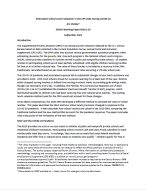
An official website of the United States government
Here’s how you know
Official websites use .gov
A .gov website belongs to an official government organization in the United States.
Secure .gov websites use HTTPS
A lock (
) or https:// means you’ve safely connected to the .gov website. Share sensitive information only on official, secure websites.
-
//
- Census.gov /
- Library /
- Census Working Papers /
- Alternative School Lunch Valuation in the CPS ASEC During COVID-19
Alternative School Lunch Valuation in the CPS ASEC During COVID-19
Alternative School Lunch Valuation in the CPS ASEC During COVID-19
Introduction
The Supplemental Poverty Measure (SPM) is an annual poverty measure released by the U.S. Census Bureau based on data collected in the Current Population Survey Annual Social and Economic Supplement (CPS ASEC). The SPM takes into account various governmental assistance programs when estimating resources for the poverty rate. One such program is the National School Lunch Program (NSLP), which provides subsidies for lunches served in public and nonprofit private schools. All student lunches in participating schools are at least partially subsidized, with eligible children receiving lunches for free or at a further reduced rate. The value of these lunches is included as a resource in the SPM, traditionally calculated based on per-meal reimbursement rates assuming a 179-day school year.
The COVID-19 pandemic and associated response led to substantial changes in how lunch assistance was provided in 2020. With most schools closed for in-person learning for at least part of the year, districts either stopped serving lunches or shifted from serving in-school meals to providing grab-and-go meals, though not necessarily every day. In addition, the Families First Coronavirus Response Act of 2020 (FFCRA) (PL 116-127) established the Pandemic Electronic Benefit Transfer (P-EBT) program, which distributed benefits to children who had been receiving free and reduced price lunches. The existing lunch valuation method used for the SPM would not account for these changes.
Given these complications, the 2020 SPM developed a different method to calculate the value of school lunches. This paper describes the NSLP and how school lunch provisions changed in response to the COVID-19 pandemic. It then describes how school lunches are valued in the 2020 SPM, comparing the traditional method and the new method that accounts for the pandemic response. The paper concludes with a discussion of the limitations of the new method.
Others in Series
Working Paper
Working Paper
Working Paper
Share
Related Information
WORKING PAPER
Supplemental Poverty Measure Working PapersSome content on this site is available in several different electronic formats. Some of the files may require a plug-in or additional software to view.
 Yes
Yes
 No
NoComments or suggestions?


Top

